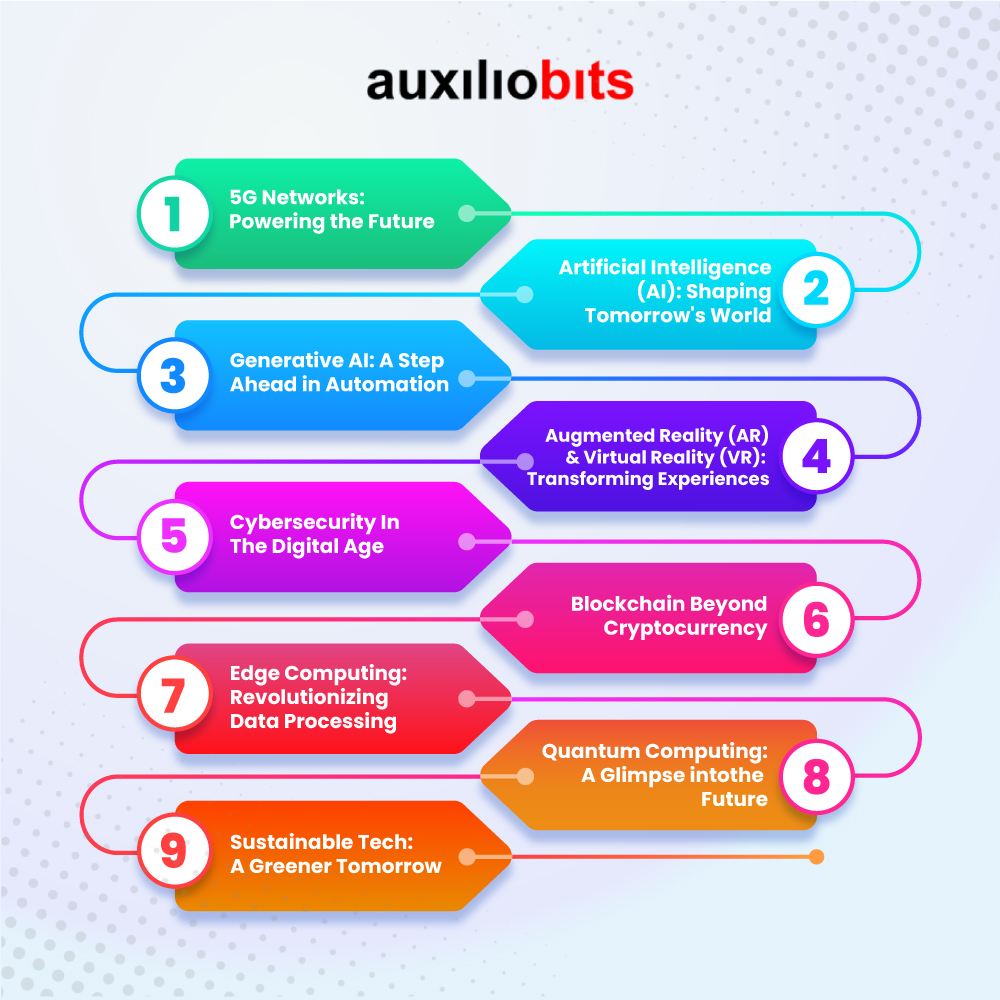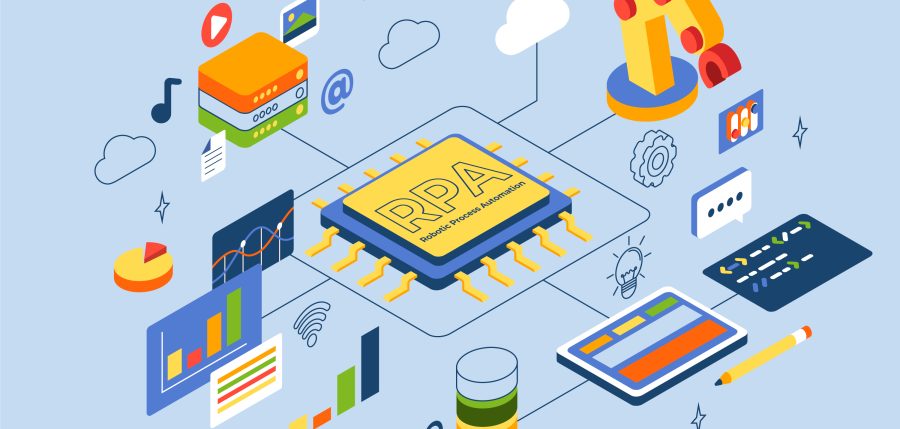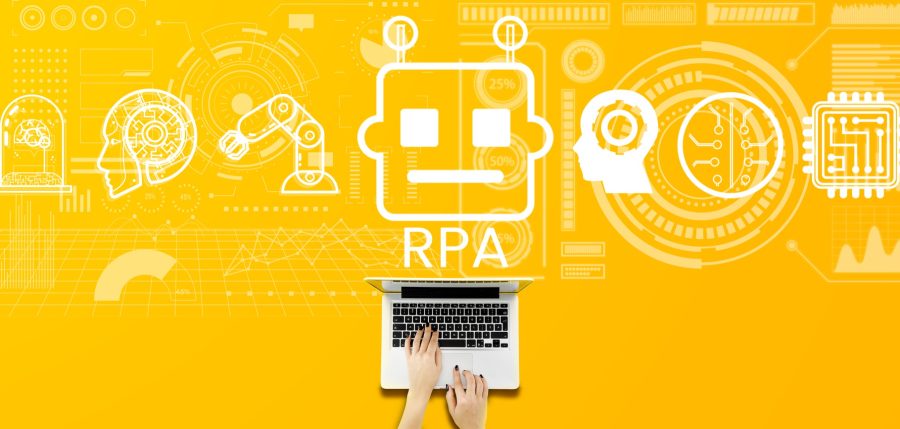
Key takeways
- The impact of technology extends beyond convenience, contributing solutions to societal challenges in areas such as education, transportation, and more.
- By 2024, 5G's impact across industries is set to be nothing short of transformative.
- According to leading analysts, Gartner, by 2025 customer service organizations with access to AI solutions in multi-channel platforms for customer engagement will see a 25% boost in operational efficiency.
- Generative AI has the power to create content in different formats just like a human would.
- AR and VR technologies have matured into sophisticated mediums, offering users seamless integration of the digital and physical worlds.
- The global cybersecurity market is projected to exceed $300 billion by 2024, reflecting ongoing advancements and investments in this critical field.
- Blockchain will impact various areas such as supply chain management, voting systems, identity verification, smart contracts, and more.
- Edge Computing brings computational power closer to the data source rather than relying on a centralized cloud.
- Quantum computing is a cutting-edge technology that harnesses the principles of quantum mechanics to perform computations faster and more efficiently than classical computers.
- Sustainability will guide the trajectory toward a future where innovation and environmental stewardship coexist harmoniously.
A world where data moves at the speed of thought, artificial minds collaborate seamlessly with human intellect, and reality is redefined through immersive experiences!
We’ll soon step into the year 2024, where the tech revolution doesn’t just continue; it surges forward, a tidal wave of innovation poised to reshape how we live, work, and dream.
So, are you curious about the top technology trends that will define 2024 and beyond?
So are we!
By the end of 2024, the global number of Internet users is projected to exceed a staggering 323.56 billion (Source: Statista). This pervasive digital connectivity goes beyond mere convenience, fundamentally altering the way we access information, connect with others, and participate in global conversation. The impact of technology extends beyond convenience, contributing solutions to societal challenges in areas such as education, transportation, and more.
Let’s peek into the future together, where simplicity meets the extraordinary, and the extraordinary becomes the new normal!
- 5G Networks: Powering the Future
- Artificial Intelligence (AI): Shaping Tomorrow’s World
- Generative AI: A Step Ahead in Automation
- Augmented Reality (AR) and Virtual Reality (VR): Transforming Experiences
- Cybersecurity In the Digital Age
- Blockchain Beyond Cryptocurrency
- Edge Computing: Revolutionizing Data Processing
- Quantum Computing: A Glimpse into the Future
- Sustainable Tech: A Greener Tomorrow
- Conclusion
5G Networks: Powering the Future
In the ever-accelerating race of technological evolution, one name stands out, destined to redefine the very fabric of connectivity – 5G.
By 2024, the average 5G download speed is anticipated to soar to more than 10 Gbps. This isn’t just about quicker movie downloads; it’s about unlocking possibilities we’ve only dreamed of – from lag-free Augmented Reality (AR) to instantaneous data transfers that defy the boundaries of the digital realm (Source: Thales Group).
The ripple effect of 5G extends far beyond smartphones. It is expected to boost every sector. For instance, in healthcare, 5G enables the realization of remote surgeries through low-latency connections, revolutionizing patient care. Manufacturing plants become smart, with real-time data exchange enhancing efficiency. By 2024, 5G’s impact across industries is set to be nothing short of transformative.

Artificial Intelligence (AI): Shaping Tomorrow's World
In the corporate world, AI is not just a tool; it’s a strategic ally. According to leading analysts, Gartner, by 2025 customer service organizations with access to AI solutions in multi-channel platforms for customer engagement will see a 25% boost in operational efficiency (Source: CX Today). From streamlining workflows to enhancing decision-making processes, AI becomes the backbone of the business landscape that values not just speed, but the intelligent utilization of data.
AI is expected to make huge strides in data-intensive, highly regulated sectors such as banking, insurance, financial services, and healthcare. AI helps meet regulatory compliance and provides a competitive edge in these sectors. AI has also enhanced efficiency in other sectors like retail, manufacturing, education, etc.
Generative AI: A Step Ahead in Automation
Generative AI has been in the news ever since it made its presence in 2022. And, with good reason! This disruptive technology has the power to create content in different formats just like how a human would.
Trends indicate that businesses are creating AI use cases relevant to their processes and embedding them in their SAP systems. These use cases are generated based on business data and its significance within the business process. According to Gartner, by 2026, 80% of enterprises will have used Gen AI APIs and models and/or deployed Gen AI-powered applications in production environments (Source: CRN).
Currently, data privacy and ethical usage are areas of concern in the deployment of Gen AI. Tech professionals are working to alleviate these issues. As per IDC researchers by 2026, 70% of cloud and software platform providers are likely to bundle Gen AI safety and governance packages within their primary services. Gartner predicts that businesses will consider the option of synthetic data to reduce the collection of personal data of customers.
Augmented Reality (AR) and Virtual Reality (VR): Realistic Experiences
AR and VR technologies have matured into sophisticated mediums, offering users seamless integration of the digital and physical worlds. The Global AR and VR market Size accounted for $ 22.6 Billion in 2021 and is expected to grow at a CAGR of 38.5% from 2022 to 2030 and reach a market size of $ 451.5 Billion by 2030 (Source: Acumen).
Some Areas Where AR/VR will be Gamechangers
- Gaming And Entertainment
Gaming and entertainment are set to undergo a paradigm shift, with AR and VR technologies redefining the very nature of these experiences. By 2024, the global AR and VR gaming market is forecasted to reach new heights, exceeding billions. It’s actually about stepping into alternate universes, where the lines between reality and fantasy blur into a seamless tapestry of adventure.
- Education And Training
The classroom of 2024 is no longer confined to physical walls; it extends into the realm of AR and VR. The global AR in the education market is estimated to grow from $3.47 billion in 2023 to a whopping $55.84 billion by 2033 (Source: Fact.MR). From virtual field trips to interactive simulations, education becomes an immersive experience that transcends the limitations of traditional learning.
- Real Estate and Retail
Real estate and retail embrace AR and VR as transformative tools, offering customers experiences beyond imagination. The retail sector’s investment in AR and VR technology is estimated to reach a staggering $61.3 billion by 2031. Imagine virtually walking through your dream home before it’s built or trying on clothes without stepping into a fitting room – AR and VR redefine the boundaries of what’s possible in these industries (Source: Business Wire).
Cybersecurity In the Digital Age
In the vast expanse of the digital frontier, where innovation thrives, so does the lurking shadow of cybersecurity threats. The spotlight on cybersecurity becomes not just a necessity but an integral part of our digital survival.
From sophisticated ransomware attacks to state-sponsored espionage, the digital battleground is evolving with a diverse range of cyber threats that demand heightened cybersecurity measures. The startling statistics on cybersecurity indicate that, by 2025, the annual cost of cybercrime is estimated to reach a staggering $10.5 trillion globally, up from $3 trillion in 2015. This highlights the expansive and escalating threat landscape. (Source: Cyber Crime Magazine)
In response to the escalating cyber threats, Gartner Forecasts Global Security and Risk Management spending to grow 14% in 2024. (Source: Gartner)
This substantial investment not only protects businesses and government entities but also fortifies a nation’s digital infrastructure, ensuring resilience against evolving cyber threats.
As IT and operational technology (OT) converge, safeguarding critical infrastructure becomes very important to ensure the smooth functioning of essential services. Data reveals that global spending on critical infrastructure protection is expected to reach $135 billion by 2024, underlining the recognition of the critical need for robust cybersecurity in safeguarding essential systems.(Source: Security Intelligence)
Tech professionals are extensively deploying AI-driven threat detection systems, enhancing the ability to identify and counteract emerging threats in real-time.
Machine Learning is another technology that plays a crucial role in cybersecurity. It enhances the ability to detect and prevent various cyber threats. It leverages advanced algorithms and statistical models to analyze vast amounts of data, identify patterns, and make predictions.
The global cybersecurity market is projected to exceed $300 billion by 2024, reflecting ongoing advancements and investments in this critical field. (Source: PR Newswire)
Blockchain Beyond Cryptocurrency
Blockchain technology is most commonly associated with cryptocurrencies like Bitcoin, where it serves as the underlying technology for recording and verifying transactions. However, its potential applications extend beyond finance. Blockchain can be used for various purposes, such as supply chain management, voting systems, identity verification, smart contracts, and more. It provides a transparent and tamper-proof platform for secure and efficient digital interactions.
Areas that Blockchain will Impact
- Blockchain In Financial Services
Blockchain’s integration into financial systems streamlines processes reduces fraud, and enhances security, marking a transformative shift in traditional financial paradigms. By 2024, global spending on Blockchain solutions in financial services is anticipated to surpass $19 billion, leading to an era of secure, transparent, and efficient financial transactions. (Source: Bankless Times)
- Supply Chain Transparency With Blockchain
Blockchain acts as an incorruptible ledger, providing real-time visibility into the origin, journey, and authenticity of products, fostering consumer trust. Hence, it comes as no surprise that the Global Blockchain supply chain market size reached a staggering USD 400.03 million in 2022 which is expected to reach USD 5403.44 million by 2031. (Source: Latest Tech. and Trends Insights)
This endorses the technology’s pivotal role in ensuring transparency throughout the supply chain
- Decentralized Finance (DeFi) Trends
The total value locked in Decentralized Finance (DeFi) platforms is set to exceed $200 billion, showcasing the disruptive impact of blockchain in challenging traditional financial intermediaries. (Source: Bitcoin)
- Regulatory Developments
Regulatory developments focus on balancing the innovation brought by blockchain with the imperative of consumer protection. By 2024, these evolving frameworks will create a conducive environment for Blockchain adoption and growth.
Edge Computing: Revolutionizing Data Processing
At its core, Edge Computing is a paradigm shift in data processing. Rather than relying on a centralized cloud, it brings computational power closer to the data source. By 2024, the global Edge Computing market is predicted to exceed $111.3 billion from $53.6 in 2023, reflecting the accelerating adoption of this transformative technology (Source: Markets and Markets). This not only reduces latency but also opens avenues for real-time data processing in situations where milliseconds matter.
Edge Computing works in cohesion with IoT (Internet of Things) to revolutionize data processing. This combination brings computational power closer to the source which not only ensures seamless device operation but also enhances efficiency by processing data in real-time at the edge.
Quantum Computing: A Glimpse into the Future
Quantum computing is a cutting-edge technology that harnesses the principles of quantum mechanics to perform computations faster and more efficiently than classical computers. Its breakthroughs challenge the norms of classical binary computing, harnessing the power of qubits to tackle computational problems that were once considered insurmountable.
Prophecy Market Insights indicate that Quantum Computing Market size accounted for US$ 387.3 billion in 2020 and is forecast to reach US$ 4531.04 billion by 2030 at a CAGR of 28.2%. (Source: Yahoo Finance)
How Quantum Computing Will Impact Sectors?
- Revolutionizing Healthcare
Quantum Computing holds the promise of revolutionizing healthcare by transforming drug discovery and molecular modeling, providing solutions to complex medical challenges.
- Enhancing Financial Sector
In the financial sector, Quantum Computing envisions faster and more complex risk assessments, offering the potential to revolutionize algorithms and decision-making processes.
- Optimizing Logistics
Quantum Computing’s impact extends to logistics, promising optimized route planning and supply chain management, streamlining processes beyond the capacity of classical computing.
Besides these, quantum computing holds promise to disrupt several other sectors.
Sustainable Tech: A Greener Tomorrow
The narrative of sustainability emerges as the protagonist, guiding the trajectory toward a future where innovation and environmental stewardship coexist harmoniously. Renewable energy takes center stage as sustainable tech pioneers harness the power of the elements to drive a cleaner, more sustainable future. The integration of smart grids, enabled by advanced technologies, ensures efficient energy distribution. Global Smart Grid Market to Surpass a Valuation of USD 123.24 Billion by 2030, Exhibiting a CAGR of 13.57%, marking a significant stride towards sustainable energy distribution and management. (Source: Yahoo Finance)
Conclusion
The tech revolution is not a mere phenomenon, it’s a powerful force that keeps changing and promising a future where we can do amazing things. From super-fast computers to eco-friendly tech making our future better, it’s like the start of a new exciting chapter in our progress story. The future is coming & it’s bringing a world where technology helps us do & explore things we haven’t even thought of yet.
Watch this space to stay updated with the latest technology trends!





